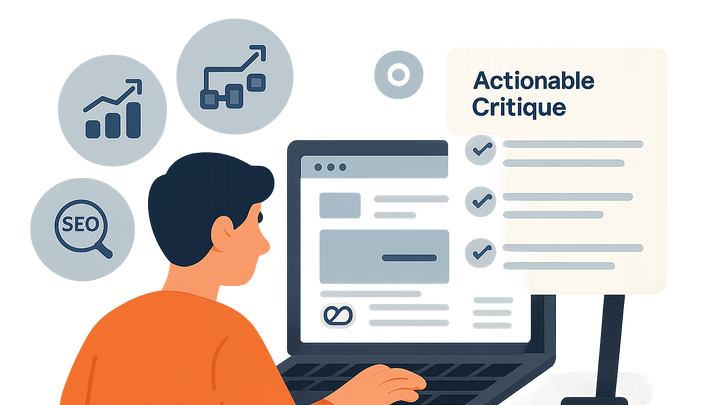Published on 2025-06-29T19:42:11Z
What is User Testing? Examples for User Testing in CRO/UX/SEO
User Testing, also known as usability testing, involves observing real users as they interact with a website to identify pain points, confusion, and friction in the user experience. In the context of Conversion Rate Optimization (CRO), UX design, and Search Engine Optimization (SEO), User Testing provides empirical data to drive design decisions rather than relying solely on assumptions. By watching participants navigate tasks, stakeholders can uncover usability issues that may affect conversion funnels, engagement metrics, and search engine rankings. Specialized tools like Prevue.me can automate portions of this process, generating actionable critiques on lead generation, accessibility, and SEO performance. Ultimately, User Testing ensures that websites are intuitive, efficient, and aligned with both user needs and business goals. This practice helps teams validate hypotheses, refine features, and prioritize improvements based on real user behavior.
User testing
Observing real users interacting with your site to identify usability issues and boost CRO, UX, and SEO.
Why User Testing Matters
User Testing reveals how actual users perceive and navigate your website. It goes beyond metrics to uncover the ‘why’ behind user behavior. By identifying pain points early, teams can address critical usability issues before they impact conversions or SEO rankings. It ensures design changes are grounded in real-world insights, improving decision-making and resource allocation.
-
Identify usability issues
Watch users struggle with navigation, forms, or content to pinpoint confusing elements or broken workflows that analytics alone might miss.
-
Validate design decisions
Test prototypes or new features with users to confirm that design choices meet user expectations and drive desired actions.
Types of User Testing
User Testing can take various forms, each suited to different goals and constraints. Choosing the right method depends on the stage of development, budget, and the level of qualitative or quantitative insights required.
-
Moderated vs unmoderated testing
Moderated tests involve a facilitator guiding participants, while unmoderated tests let users complete tasks independently, often remotely.
- Moderated testing:
Provides depth through real-time probing and follow-up questions, but can be resource-intensive.
- Unmoderated testing:
Scales easily and collects faster responses, though it may lack context for user behaviors.
- Moderated testing:
-
Remote testing
Participants use their own devices in their natural environment, offering authentic insights at lower cost.
-
In-person testing
Conducted in a controlled setting, allowing close observation of non-verbal cues and deeper interaction.
-
Guerilla testing
Informal, quick sessions with random users in public spaces to gather rapid feedback on basic tasks.
Steps to Conduct User Testing
A structured approach ensures your User Testing is effective, repeatable, and yields actionable insights. Follow these core steps to maximize value from each session.
-
Define objectives
Set clear goals, target user profiles, and specific tasks to assess based on your CRO, UX, and SEO priorities.
-
Recruit participants
Select users who match your personas, ensuring diversity in demographics and technical proficiency.
-
Design test scenarios
Create realistic tasks that reflect key user journeys, such as signing up, searching for products, or filling checkout forms.
-
Conduct sessions
Facilitate or remotely record sessions, encouraging users to think aloud and express frustrations or praise in real time.
-
Analyze & act
Aggregate findings, prioritize issues by impact, and translate insights into design or content improvements.
Benefits for CRO, UX, and SEO
Integrating User Testing into your optimization workflow yields measurable improvements across conversion rates, user satisfaction, and search visibility. Here’s how leveraging real user feedback translates to tangible gains.
-
Improved conversion rates
By removing friction points in user flows, you can reduce drop-offs and guide visitors toward desired actions, boosting ROI.
-
Enhanced user experience
Deliver intuitive interfaces that resonate with user expectations, increasing engagement and repeat visits.
-
Better seo performance
Positive user signals like low bounce rates and longer dwell time can improve search rankings, driving more organic traffic.
Leveraging Prevue.me for User Testing
prevue.me streamlines the User Testing process by automating audits and surfacing prioritized critiques. It integrates CRO, UX, SEO, and accessibility reviews into a single actionable report.
-
Automated ux audits
Embed prevue.me’s audit script to instantly analyze page elements:
<script src="https://embed.prevue.me/audit.js"></script>It highlights usability errors and suggests improvements in real time.
-
Actionable cro insights
Receive prioritized recommendations, such as form optimizations and call-to-action tweaks, to maximize lead generation and revenue growth.
-
Accessibility and seo checks
Run comprehensive scans for accessibility compliance (WCAG) and SEO best practices, ensuring your site is inclusive and search-engine friendly.
